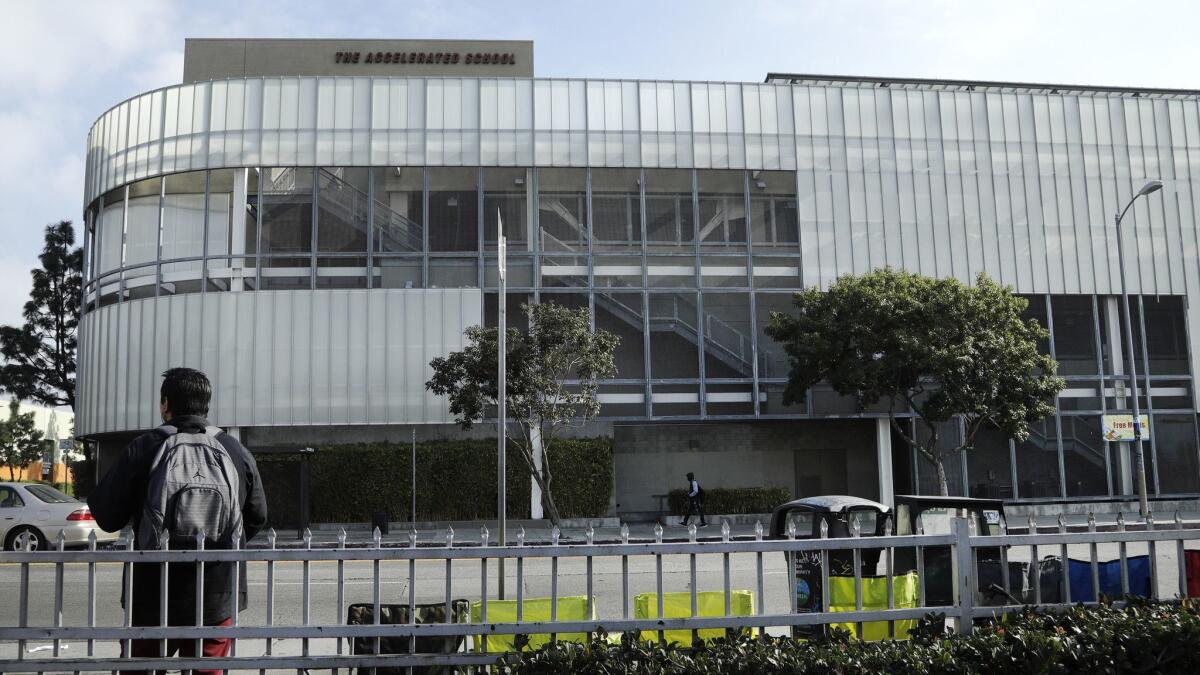Op-Ed: Striking teachers scapegoated charter schools, but they’re not the problem

- Share via
Listening to the rhetoric of the teachers unions, one might have thought the teachers’ strike in Los Angeles was about charter schools. “When someone says there’s no money, why isn’t there money?” National Education Assn. President Lily Eskelsen García asked on MSNBC the first day of the strike.
“A big reason is because they’ve given it away to for-profit charters. If you’re in the charter industry, what do you want to do? You want to create horrible public schools…. The billionaires who are behind this, the venture capitalists, the Wall Street guys, are out to make money on public schools.”
This was nonsense: California never had many for-profit charters, and last year the legislature banned them entirely. Most of the people “behind” L.A.’s 277 charter schools are dedicated educators who work 60 hours a week to help low-income children. They’re more like Peace Corps volunteers than “Wall Street guys.”
But Garcia’s comments were illuminating. Clearly the unions saw the strike as an opportunity to discredit charters.
Why are teachers’ unions so upset about independent charter schools? Because most choose not to unionize, though they are free to do so.
For those confused by the rhetoric, independent charter schools are public schools, supported by taxpayers’ money but operated by nonprofit organizations. They function outside the stifling rules and bureaucratic controls of the Los Angeles Unified School District. They have to follow many laws, and the educational achievement of their students is closely monitored, but they are free to hire the teachers they want, pay them what it takes to attract sufficient talent, and fire those who are ineffective.
They can also craft innovative learning models. Charter schools include Montessori-based elementaries, dual-language immersion programs and career-tech high schools, to name just a few. But unlike some district-run magnet schools for high achievers, charters cannot choose their students. If too many sign up — and there are 50,000 kids on waiting lists for them in L.A. — the school has to hold a lottery. In this way, they are more “public” than many selective district schools.
To be sure, families have to choose charter schools, so kids with disengaged families are more likely to remain in district schools. While this gives charters an advantage, it may be outweighed by the fact that charters get close to $2,000 less per child than district schools.
Overall, charter students perform significantly better than district students. Results vary from school to school, but with demographically similar students, L.A. charters, on average, have higher test scores, higher graduation rates, and higher college preparedness rates than schools run by LAUSD. As with any collection of inner-city schools, some charters struggle — but they are usually closed, while failing district schools often survive for decades.
So why are teachers unions so upset about them? Because most choose not to unionize, though they are free to do so. (LAUSD’s “affiliated charters” — district schools that have converted — remain unionized.)
As independent charters have grown to educate 20% of public school students in Los Angeles, the union has shrunk. Hence charters are a threat — not to teachers, not to students, but to unions.
This explains why United Teachers Los Angeles blamed the district’s financial problems on charters. One of their assertions was that, by taking students away, charters drained more than $500 million a year from the district’s $7.5 billion budget. The union’s solution is a charter moratorium and cap.
The truth is, even if all charter students returned tomorrow, LAUSD would still have profound financial problems. For years, the district underfunded its pensions, and the state has now forced it to play catch-up. More important, it has one of the most generous health benefits in the country. Teachers and their dependents get full health insurance, with no premiums or co-pays — for life, if they’ve put in enough years in the classroom.
Enter the Fray: First takes on the news of the minute »
Between 2013-14 and 2017-18, LAUSD spending on benefits shot up 44%, while the number of teachers declined by 13%. Benefits now consume $2 billion a year — almost equal to what the district spends on teachers’ salaries.
LAUSD’s unions could easily lower health insurance costs if they wanted to, because they control eight of nine seats on the committee that sets health benefits. They could require retirees to shift to Medicare as their primary insurer once they hit 65, for instance, leaving the district to cover only supplemental costs.
Today, the district spends $500 million more than it takes in each year, and its reserves have fallen below 1% of spending. By law, Los Angeles County must take fiscal control of the district if reserves remain under 1%. If things get bad enough, the state will step in. Either one could throw out collective bargaining agreements, change benefit packages, and cut other spending.
It’s hard to fault the union for demanding a 6.5% raise for teachers, given California’s low levels of funding for public education. But the 6% raise the district granted could trigger a takeover, precisely because of the generous benefits the union has negotiated. By scapegoating charters, the union kept most of the media from noticing that particular irony.
David Osborne, author of “Reinventing America’s Schools” and “Reinventing Government,” leads the K-12 education work of the Progressive Policy Institute.
More to Read
A cure for the common opinion
Get thought-provoking perspectives with our weekly newsletter.
You may occasionally receive promotional content from the Los Angeles Times.









